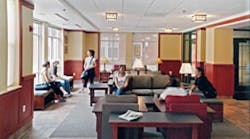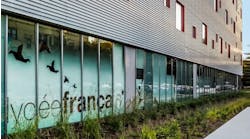Campus safety and security continue to be important issues on every campus today. But it's not just about adding new access technologies and safety policies. From planning to building design to landscaping, a variety of factors can have an impact on the actual safety — and how secure students feel — on campus. Many of these factors have to do with how a campus — and the residences on it — are designed.
When thinking about security on campus, consider these areas:
-
A safe master plan. Creating safety and security on campus starts with a global perspective. How does residence life fit into the larger framework of the campus? Do student residences make up the core of the campus, or are they situated on the edges? If they are on the edges, how do they fit into the neighborhoods around them? How safe are those neighborhoods? Understanding typical travel routes between residences and classrooms or recreation centers is important to ensure that safety is a part of students' daily experience.
-
A feeling of community. One of the most important considerations for student living is developing a feeling of community within the residence. Layouts and design elements that enhance community also contribute to feelings of security among residents who "know each other." Feeling comfortable within a space is important to a student's sense of safety and makes unwanted guests easier to spot.
-
Space between the buildings. Walkways, common areas and park spaces between buildings can pose unnecessary hazards when not well-lighted or designed strategically. Providing open and clearly organized spaces, manicuring landscaping so that it doesn't hinder sightlines and eliminating awkward dark corners are a few moves that can transform outdoor spaces.
-
Effective lighting. It may seem obvious that well-lighted pathways between destinations help students feel — and stay — safe. Lighting extends to many other areas as well. Consider the lighting inside hallways and stairwells and in parking lots. If using wall-mounted outdoor lighting, reconsider. Glare caused by these lights can be blinding and create unsafe shadows for criminals to hide.
-
A visible security presence. Careful — and prominent — placement of blue security phone systems and security cameras creates a subconscious message that "this is a safe place." Although it's unlikely a crime will be stopped in process because of these measures, their prominence on campus can be an effective preventive measure. Within buildings, a clear line of sight should exist between entries and common areas and the front desk or resident assistant's room.
-
Controlled access. From key cards to proximity readers to biometric thumbprint readers, security technology is advancing continually. No matter which systems work best for your campus, you should establish clear, single points of entry for residence halls and close other options. Trackable access controls can also be used effectively to separate common areas from residential spaces, and limit access to individual bedrooms and bathrooms for added privacy and security.
Treanor Architects' Student Life division, Lawrence, Kan., has been creating environments for students' personal, social and academic success since 1981. The firm has programmed or designed 140 student life projects on 65 national and international college campuses. Learn more at www.treanorstudentlife.com.


